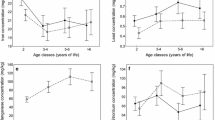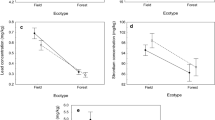Abstract
The study reports lead concentrations and lead and strontium stable-isotope ratios in mandibular molars of roe deer from three different areas in western Germany. Lead concentrations in third molars ranged between 0.23 and 36.61 µg/g (dry weight). Comparing lead concentrations in first molars and third molars in a group of ca. 1.5- or ca. 2.5-year-old individuals from the same area revealed an effect of tooth age on tooth lead content. The higher lead concentrations in the first molars were attributed to the longer period of lead accumulation by the dentin of these teeth compared with the later-forming third molars. Differences in lead isotopic signatures of the teeth were observed between the three areas, presumably reflecting variation in exposure to different sources of environmental lead. We also found marked variation in the 87Sr/86Sr isotope ratios of the teeth, with only a small overlap in values between two of the areas. Strontium isotope analysis alone or in combination with lead isotope analyses can be a useful means of assessing the provenance of deer teeth of unknown geographical origin.



Similar content being viewed by others
References
Åberg G (2001) Tracing pollution and its sources with isotopes. Water Air Soil Pollut 130:1577–1582
Åberg G, Fosse G, Stray H (1998) Man, nutrition and mobility: A comparison of teeth and bone from the medieval era and the present from Pb and Sr isotopes. Sci Total Environ 224:109–119
Åberg G, Charalampides G, Fosse G, Hjelmseth H (2001) The use of Pb isotopes to differentiate between contemporary and ancient sources of pollution in Greece. Atmos Environ 35:4609–4615
Andersen R, Duncan P, Linnell JDC (eds) (1998) The European roe deer: the biology of success. Scandinavian University Press, Oslo, p 376
Ando N, Isono T, Sakurai Y (2005) Trace elements in the teeth of Steller sea lions (Eumetopias jubatus) from the North Pacific. Ecol Res 20:415–423
Appleton J, Lee KM, Sawicka Kapusta K, Damek M, Cooke M (2000) The heavy metal content of the teeth of the bank vole (Clethrionomys glareolus) as an exposure marker of environmental pollution in Poland. Environ Pollut 110:441–449
Arora M, Kennedy BJ, Elhlou S, Pearson NJ, Walker DM, Bayl P, Chan SWY (2006) Spatial distribution of lead in human primary teeth as a biomarker of pre- and neonatal lead exposure. Sci Total Environ 371:55–62
Bayo J, Moreno-Grau S, Martinez MJ, Moreno J, Angosto JM, Guillén Pérez JJ, Garcia Marcos L, Moreno-Clavel J (2001) Environmental and physiological factors affecting lead and cadmium levels in deciduous teeth. Arch Environ Contam Toxicol 41:247–254
Beard BL, Johnson CM (2000) Strontium isotope composition of skeletal material can determine the birth place and geographic mobility of humans and animals. J Forensic Sci 45:1049–1061
Bellis DJ, McLeod CW, Satake K (2002) Pb and 206Pb/207Pb isotopic analysis of a tree bark pocket near Sheffield, UK recording historical change in airborne pollution during the 20th century. Sci Total Environ 289:169–176
Bentley RA, Krause R, Price TD, Kaufman B (2003) Human mobility at the early Neolithic settlement of Vaihingen, Germany: Evidence from strontium isotope analysis. Archaeometry 45:471–486
Bindler R, Renberg I, Klaminder J, Emteryd O (2004) Tree rings as Pb pollution archives? A comparison of 206Pb/207Pb isotope ratios in pine and other environmental media. Sci Total Environ 319:173–183
Budd P, Montgomery J, Evans J, Barreiro B (2000) Human tooth enamel as a record of the comparative lead exposure of prehistoric and modern people. Sci Total Environ 263:1–10
Budd P, Montgomery J, Evans J, Trickett M (2004) Human lead exposure in England from approximately 5500BP to the 16th century AD. Sci Total Environ 318:45–58
Bu-Olayan AH, Thomas BV (1999) Dental lead levels in residents from industrial and suburban areas of Kuwait. Sci Total Environ 226:133–137
Caurant F, Aubaij A, Lahaye V, Van Canneyt O, Rogan E, Lopez A, Addink M, Churlaud C, Robert M, Bustamente P (2006) Lead contamination of small cetaceans in European waters—the use of stable isotopes for identifying the source of lead exposure. Mar Environ Res 62:131–148
Cleymaet R, Bottenberg P, Slop D, Clara R, Coomans D (1991) Study of lead and cadmium content of surface enamel of schoolchildren from an industrial area in Belgium. Community Dent Oral Epidemiol 19:107–111
Ericson JE (2001) Enamel lead biomarker for prenatal exposure assessment. Environ Res A 87:136–140
Evans RD, Richner P, Outridge PM (1995) Micro-spatial variation of heavy metals in the teeth of walrus as determined by laser ablation ICP-MS: the potential for reconstructing a history of metal exposure. Arch Environ Contam Toxicol 28:55–60
Ewers U, Brockhaus A, Winneke G, Freier I, Jermann E, Krämer U (1982) Lead in deciduous teeth of children living in a non-ferrous smelter area and a rural area of the FRG. Int Arch Occup Environ Health 50:139–151
Farmer JG, MacKenzie AB, Moody GH (2006) Human teeth as historical biomonitors of environmental and dietary lead: some lessons from isotopic studies of 19th and 20th century archival material. Environ Geochem Health 28:421–430
Flament P, Bertho ML, Deboudt K, Véron A, Puskaric E (2002) European isotopic signatures for lead in atmospheric aerosols: a source apportionment based upon 206Pb/207Pb ratios. Sci Total Environ 296:35–57
Gdula-Argasinska J, Appleton J, Sawicka-Kapusta K, Spence B (2004) Further investigation of the heavy metal content of the teeth of the bank vole as an exposure indicator of environmental pollution in Poland. Environ Pollut 131:71–79
Gil F, Facio A, Villanueva E, Pérez ML, Tojo R, Gil A (1996) The association of tooth lead content with dental health factors. Sci Total Environ 192:183–191
Grabert H (1998) Abriß der Geologie von Nordrhein-Westfalen. Schweizerbart, Stuttgart
Gulson B, Wilson D (1994) History of lead exposure in children revealed from isotopic analyses of teeth. Arch Environ Health 49:279–283
Habermehl KH (1985) Altersbestimmung bei Wild- und Pelztieren, second edition. Parey, Hamburg
Hopper JF, Ross HB, Sturges WT, Barrie LA (1991) Regional source discrimination of atmospheric aerosols in Europe using the isotopic composition of lead. Tellus 43B:45–60
Horwitz EP, Chiarizia R, Dietz ML (1992) A novel strontium-selective extraction chromatographic resin. Solv Extr Ion Exch 10:313–336
Horwitz EP, Dietz ML, Rhoads S, Felinto C, Gale NH, Houghton J (1994) A lead selective extraction chromatographic resin and its application to the isolation of lead from geological samples. Anal Chimica Acta 292:263–273
Karahalil B, Aykanat B, Ertas N (2007) Dental lead levels in children from different urban and suburban areas of Turkey. Int J Hyg Environ Health 210:107–122
Kierdorf H, Kierdorf U (1989) Untersuchungen zur Entwicklungsgeschichte des Gebisses beim Europäischen Reh (Capreolus c. capreolus L., 1758). Zool Jb Anat 119:37–75
Kierdorf U, Kierdorf H (2005) Antlers as biomonitors of environmental pollution by lead and fluoride: a review. Eur J Wildl Res 51:137–150
Knudson KJ, Tung TA, Nystrom KC, Price TD, Fullagar PD (2005) The origin of the Juch’uypampa cave mummies. Strontium isotope analysis of archaeological human remains from Bolivia. J Archaeol Sci 32:903–913
Large D, Schaeffer R, Höhndorf A (1983) Lead isotope data from selected galena occurrences in the North Eifel and North Sauerland, Germany. Miner Depos 18:235–243
Lutz W (1985) Ergebnisse der Untersuchungen von Rehen (Capreolus capreolus L.) und Hasen (Lepus europaeus Pallas) auf Schwermetalle und chlorierte Kohlenwasserstoffe in Nordrhein-Westfalen. Z Jagdwiss 31:153–175
Maňkovská B (1980) The concentration of four toxic elements in the teeth of roe deer from the area of an aluminium plant. Biologia (Bratisl) 35:819–822
Nowak B, Chmielnicka J (2000) Relationship of lead and cadmium to essential elements in hair, teeth, and nails of environmentally exposed people. Ecotoxicol Environ Saf 46:265–274
Rieck W (1955) Die Setzzeit bei Reh-, Rot- und Damwild in Mitteleuropa. Z Jagdwiss 1:69–75
Schneider FK (1982) Untersuchungen über den Gehalt an Blei und anderen Schwermetallen in den Böden und Halden des Raumes Stolberg (Rheinland). Geol Jahrb Reihe D 53:1–31
Stack MV (1990) Lead in human bones and teeth. In: Priest ND, Van de Vyver FL (eds) Trace metals and fluoride in bones and teeth. CRC, Boca Raton, pp 191–218
Sykes NJ, White J, Hayes TE, Palmer MR (2006) Tracking animals using strontium isotopes in teeth: the role of fallow deer (Dama dama) in Roman Britain. Antiquity 80:948–959
Tataruch F, Kierdorf H (2003) Mammals as biomonitors. In: Markert BA, Breure AM, Zechmeister G (eds) Bioindicators and biomonitors: principles, concepts and applications. Elsevier, Amsterdam, pp 737–772
Trüby P (1994) Zum Schwermetallhaushalt von Waldbäumen. Freibg Bodenkdl Abh 33:1–286
Tvinnereim HM, Eide R, Riise T, Wesenberg GR, Fosse G, Steiness E (1997) Lead in primary teeth from Norway: changes in lead levels from the 1970s to the 1990s. Sci Total Environ 207:165–177
Umweltbundesamt (1997) Daten zur Umwelt. E Schmidt. Verlag, Berlin, p 570
Von Storch H, Costa-Cabral M, Hagner C, Feser F, Pacyna J, Pacyna E, Kolb S (2003) Four decades of gasoline lead emissions and control policies in Europe: a retrospective assessment. Sci Total Environ 311:151–176
Wallach S, Chausmer AB (1990) Metabolism of trace metals in animals and man: part I: non-essential pollutant metals. In: Priest ND, Van de Vyver FL (eds) Trace metals and fluoride in bones and teeth. CRC, Boca Raton, pp 231–252
Wiechuła D, Fischer A, Kwapuliński J, Loska K, Fischer T, Kurpas P (2006) Multivariate statistical analysis of metal concentrations in teeth of residents of Silesian region, southern Poland. Arch Environ Contam Toxicol 51:314–320
Witkowski SA, Ault SR, Field RW (1982) Lead concentrations in white-tailed deer mandibles and teeth. Bull Environ Contam Toxicol 28:561–565
Acknowledgements
This study was supported by the Ministry of the Environment of the federal state of North Rhine-Westphalia, Germany, as part of the research program “Wildlife species as bioindicators of environmental pollution in North Rhine-Westphalia. We thank Walburga Lutz (Institute of Wildlife Research, Bonn) for providing access to the specimens used in the study.
Author information
Authors and Affiliations
Corresponding author
Additional information
Communicated by: W. Lutz
Rights and permissions
About this article
Cite this article
Kierdorf, H., Åberg, G. & Kierdorf, U. Lead concentrations and lead and strontium stable-isotope ratios in teeth of European roe deer (Capreolus capreolus) . Eur J Wildl Res 54, 313–319 (2008). https://doi.org/10.1007/s10344-007-0152-9
Received:
Revised:
Accepted:
Published:
Issue Date:
DOI: https://doi.org/10.1007/s10344-007-0152-9




